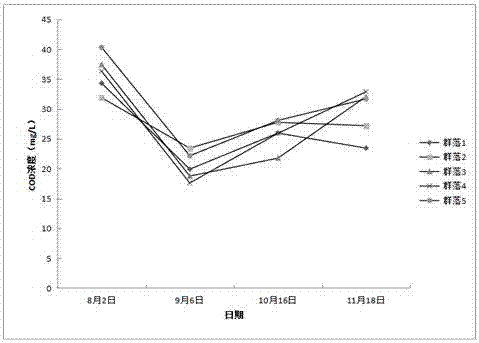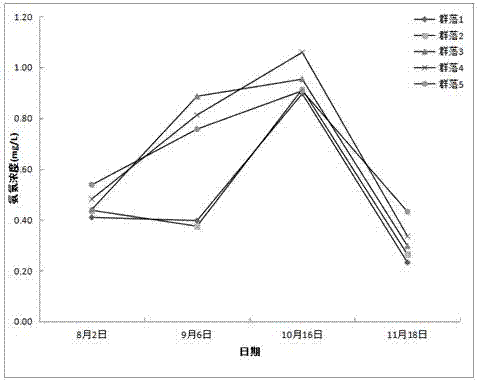Building method of aquatic-terrestrial wetland emergent plant community
A technology of emergent plants and construction methods, which is applied in the fields of botany equipment and methods, plant cultivation, chemical instruments and methods, etc., can solve the problems of losing ornamental value, etc., and achieve the effects of strong purification and enhanced landscape effects
- Summary
- Abstract
- Description
- Claims
- Application Information
AI Technical Summary
Problems solved by technology
Method used
Image
Examples
Embodiment 1
[0028] A method for constructing lakeside wetland emergent plant communities, comprising the following steps:
[0029] S1. Select the lakeside shallow water area of Haizhu Lake in Guangzhou City with a water depth of less than 0.5 meters as the planting area for emergent plants;
[0030] S2. Construct the emergent plant community in the selected planting area: the emergent plants are papyrus, calamus, canna, barracuda; in terms of spatial configuration, papyrus, calamus, and canna are planted respectively from the shallow water area to the shore , barracuda (namely community 1);
[0031] S3. After the planting is completed, pest control should be carried out in time, and weeds and duckweed-like harmful plants in the plant area should be removed in time to prevent the adverse effects of excessive accumulation of harmful aquatic plants on emerging plants.
[0032] Among them, the plant height and number of tillers of emergent plants are: Canna ≥ 0.5 meters, 3; Barracuda ≥ 0.3...
Embodiment 2
[0035] A method for constructing lakeside wetland emergent plant communities, comprising the following steps:
[0036] S1. The planting area of emergent plants is selected as tidal flats or islands formed by blowing and filling the lakeside with sediment. The beach elevation of tidal flats or islands should ensure local dew or average water depth in the basement restoration area during the planting season in spring and summer. The range is 0-0.3 meters, and the bandwidth of the repair area is 1-5 meters;
[0037] S2. Construct the emergent plant community in the selected planting area: the emergent plants are papyrus, calamus, canna, pikegrass; mainly calamus, and the rows of calamus are mixed with paper from the shallow water area to the bank Sedge rows, canna rows, pike grass rows;
[0038] S3. After the planting is completed, pest control should be carried out in time, and weeds and duckweed-like harmful plants in the plant area should be removed in time to prevent the a...
PUM
 Login to View More
Login to View More Abstract
Description
Claims
Application Information
 Login to View More
Login to View More - R&D
- Intellectual Property
- Life Sciences
- Materials
- Tech Scout
- Unparalleled Data Quality
- Higher Quality Content
- 60% Fewer Hallucinations
Browse by: Latest US Patents, China's latest patents, Technical Efficacy Thesaurus, Application Domain, Technology Topic, Popular Technical Reports.
© 2025 PatSnap. All rights reserved.Legal|Privacy policy|Modern Slavery Act Transparency Statement|Sitemap|About US| Contact US: help@patsnap.com


